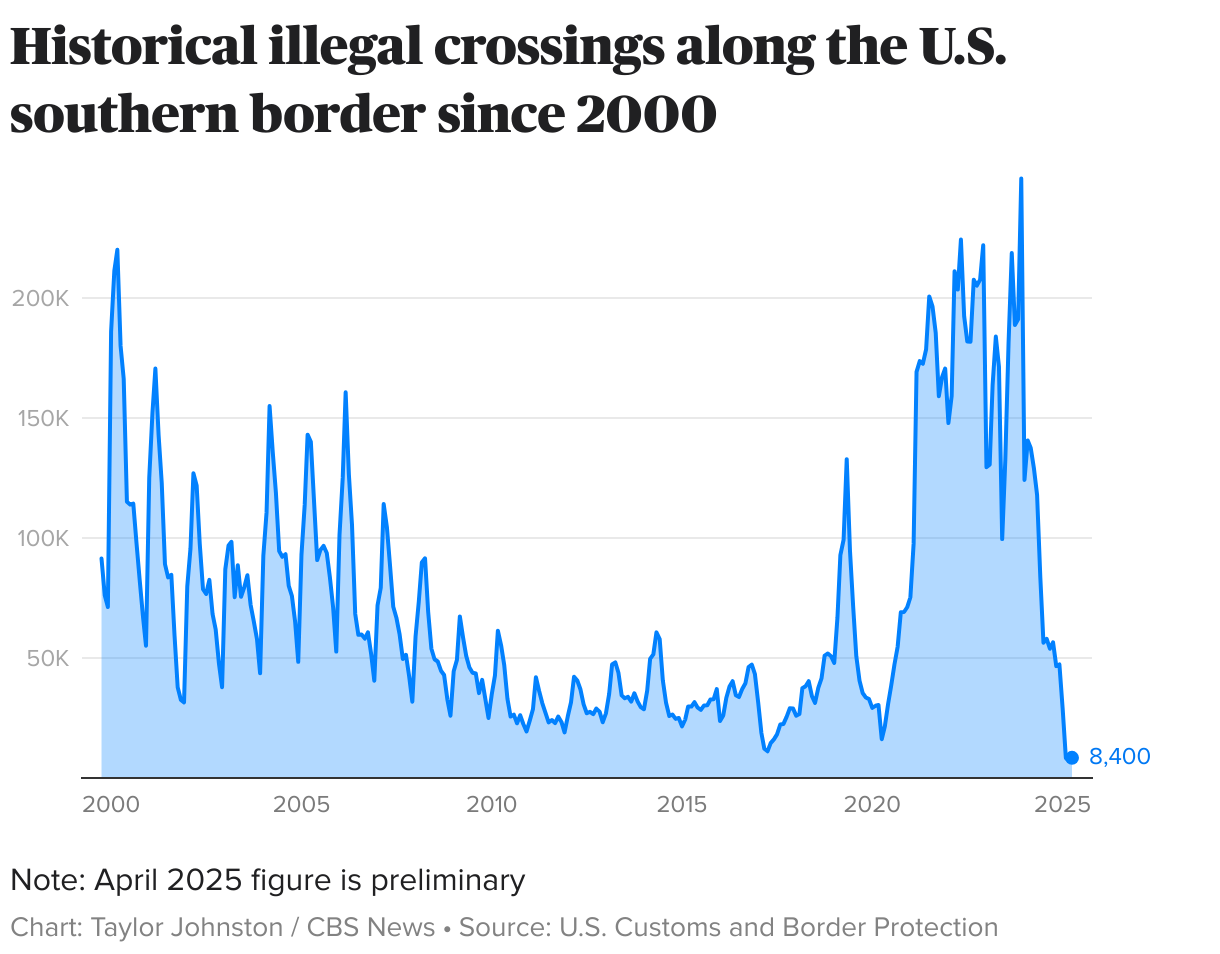The number of migrants crossing the U.S. southern border unlawfully continued to be at a historically low level in April, three full months into President Trump’s aggressive efforts to curtail illegal immigration, according to internal federal data obtained by CBS News.
In April, Border Patrol agents recorded roughly 8,400 apprehensions of migrants who had crossed the U.S.-Mexico border without authorization, according to the preliminary Department of Homeland Security statistics, which have not been officially published.
April’s preliminary tally, which could be adjusted once the data is officially published, is a slight increase from March, when Border Patrol recorded 7,200 apprehensions at the southern border. And it is nearly identical to the 8,300 apprehensions the agency recorded there in February.
The number of illegal crossings during Mr. Trump’s first three full months in office represents a seismic change at the U.S.-Mexico border.
The apprehensions reported in February, March and April are the lowest tallies recorded by the Border Patrol in its public monthly dataset, which stretches back to fiscal year 2000. The last time Border Patrol averaged fewer than 9,000 monthly apprehensions along the southern border over a year was in the late 1960s, according to historical agency figures.

The historically low levels of illegal crossings under Mr. Trump also stand in sharp contrast to the unprecedented influx in migrant arrivals at the southern border under the Biden administration. During a record-breaking spike in illegal crossings in December 2023, Border Patrol averaged 8,000 apprehensions per day, with the agency processing over 10,000 migrants on some days.
Driving the dramatic drop in illegal entries at the southern border, Trump administration officials have argued, is the president’s far-reaching immigration crackdown.
Arguing that the country is facing an “invasion,” the president has all but shuttered the American asylum system, authorizing U.S. border officials to rapidly deport migrants to Mexico or their home countries, without court hearings. Thousands of additional active-duty troops have been deployed to fortify the southern border and, in some cases, detain migrants.
The Trump administration has also dismantled Biden-era programs that allowed some migrants to enter the U.S. legally, arguing that the policies were contrary to federal immigration law.
In the interior of the country, the administration has dramatically broadened who is eligible to be arrested and deported by Immigration and Customs Enforcement, reversing Biden-era rules that largely limited immigration arrests to serious criminals, national security threats and recent arrivals.
In some cases, the administration has flown migrant detainees to the U.S. Naval Base at Guantanamo Bay, as well as to El Salvador, where nearly 300 Venezuelans accused of being gang members remain detained at a notorious mega-prison.
Many Democrats have denounced Mr. Trump’s immigration policies as draconian and inhumane, arguing they have trampled on migrants’ due process rights. Nearly every single major immigration and border policy enacted by the president faces legal challenges by Democratic-led states and advocates who argue the changes violate U.S laws, including obligations to asylum-seekers fleeing persecution.
Colleen Putzel-Kavanaugh, who studies U.S. immigration policies at the Migration Policy Institute, a Washington-based think tank, said the Trump administration’s tough rhetoric and actions are likely contributing to migrants rethinking plans to cross the U.S. border.
Putzel-Kavanaugh said it’s “one thing to be sent back to your home country if you have a fear, but to be sent to a high-security prison in El Salvador is an entirely different threat.”
Migration to the southern border, Putzel-Kavanaugh added, began dropping last year, after the Biden administration convinced Mexican officials to stop more U.S.-bound migrants. Unlawful border crossings dropped further after President Biden sharply restricted asylum through an executive order in June 2024.
Putzel-Kavanaugh cautioned that migration patterns can change rapidly, noting that crossings appear to have plateaued since the massive plunge in Mr. Trump’s first weeks in office. Still, the U.S.-Mexico border remains the quietest it has been in decades.
Roland Salinas, the Democratic mayor of Eagle Pass, Texas, said his border town was “ground zero” during the migration crisis faced by the Biden administration. In late 2023, thousands of migrants crossed into the Eagle Pass area daily. But he said that has changed markedly since Mr. Trump took office.
“The numbers are super low — almost non-existent,” Salinas said Thursday.
Camilo Montoya-Galvez is the immigration reporter at CBS News. Based in Washington, he covers immigration policy and politics.
The post Migrant crossings at U.S.-Mexico border stay at historically low levels appeared first on CBS News.





